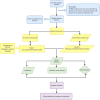Development and Validation of Prediction Models for All-Cause Mortality and Cardiovascular Mortality in Patients on Hemodialysis: A Retrospective Cohort Study in China
- PMID: 37534232
- PMCID: PMC10392814
- DOI: 10.2147/CIA.S416421
Development and Validation of Prediction Models for All-Cause Mortality and Cardiovascular Mortality in Patients on Hemodialysis: A Retrospective Cohort Study in China
Abstract
Purpose: This study aimed to develop two predictive nomograms for the assessment of long-term survival status in hemodialysis (HD) patients by examining the prognostic factors for all-cause mortality and cardiovascular (CVD) event mortality.
Patients and methods: A total of 551 HD patients with an average age of over 60 were included in this study. The patients' medical records were collected from our hospital and randomly allocated to two cohorts: the training cohort (n=385) and the validation cohort (n=166). We employed multivariate Cox assessments and fine-gray proportional hazards models to explore the predictive factors for both all-cause mortality and cardiovascular event mortality risk in HD patients. Two nomograms were established based on predictive factors to forecast patients' likelihood of survival for 3, 5, and 8 years. The performance of both models was evaluated using the area under the curve (AUC), calibration plots, and decision curve analysis.
Results: The nomogram for all-cause mortality prediction included seven factors: age ≥ 60, sex (male), history of diabetes and coronary artery disease, diastolic blood pressure, total triglycerides (TG), and total cholesterol (TC). The nomogram for cardiovascular event mortality prediction included three factors: history of diabetes and coronary artery disease, and total cholesterol (TC). Both models demonstrated good discrimination, with AUC values of 0.716, 0.722 and 0.725 for all-cause mortality at 3, 5, and 8 years, respectively, and 0.702, 0.695, and 0.677 for cardiovascular event mortality, respectively. The calibration plots indicated a good agreement between the predictions and the decision curve analysis demonstrated a favorable clinical utility of the nomograms.
Conclusion: Our nomograms were well-calibrated and exhibited significant estimation efficiency, providing a valuable predictive tool to forecast prognosis in HD patients.
Keywords: all-cause; cardiovascular; hemodialysis; model; mortality; nomogram.
© 2023 Yang et al.
Conflict of interest statement
The authors declare that they have no competing interests.
Figures









Similar articles
-
Nomogram for predicting 1-, 5-, and 10-year survival in hemodialysis (HD) patients: a single center retrospective study.Ren Fail. 2021 Dec;43(1):1508-1519. doi: 10.1080/0886022X.2021.1997762. Ren Fail. 2021. PMID: 34779699 Free PMC article.
-
Development and external validation of two nomograms to predict overall survival and occurrence of distant metastases in adults after surgical resection of localised soft-tissue sarcomas of the extremities: a retrospective analysis.Lancet Oncol. 2016 May;17(5):671-80. doi: 10.1016/S1470-2045(16)00010-3. Epub 2016 Apr 5. Lancet Oncol. 2016. PMID: 27068860
-
Development and Validation of a Nomogram for Predicting All-Cause Mortality in Patients with Hemodialysis Having Pulmonary Hypertension.Cardiorenal Med. 2023;13(1):282-291. doi: 10.1159/000533674. Epub 2023 Aug 28. Cardiorenal Med. 2023. PMID: 37640012 Free PMC article.
-
Construction of a nomogram to reveal the prognostic benefit of spontaneous intracranial hemorrhage among Chinese adults: a population-based study.Neurol Sci. 2022 Apr;43(4):2449-2460. doi: 10.1007/s10072-021-05684-3. Epub 2021 Oct 25. Neurol Sci. 2022. PMID: 34694512
-
Development and validation of a nomogram for predicting the 6-months survival rate of patients undergoing incident hemodialysis in China.BMC Nephrol. 2022 Jul 1;23(1):234. doi: 10.1186/s12882-022-02864-x. BMC Nephrol. 2022. PMID: 35778681 Free PMC article.
Cited by
-
Association between illness perception and social alienation among maintenance hemodialysis patients: The mediating role of fear of progression.PLoS One. 2024 Apr 2;19(4):e0301666. doi: 10.1371/journal.pone.0301666. eCollection 2024. PLoS One. 2024. PMID: 38564570 Free PMC article.
-
Delving into biomarkers and predictive modeling for CVD mortality: a 20-year cohort study.Sci Rep. 2025 Feb 3;15(1):4134. doi: 10.1038/s41598-025-88790-y. Sci Rep. 2025. PMID: 39900681 Free PMC article.
-
Hemodialysis and Peritoneal Dialysis.Ren Fail. 2025 Dec;47(1):2512405. doi: 10.1080/0886022X.2025.2512405. Epub 2025 Jun 4. Ren Fail. 2025. PMID: 40467335 Free PMC article.
-
Mortality Risk Prediction Models for People With Kidney Failure: A Systematic Review.JAMA Netw Open. 2025 Jan 2;8(1):e2453190. doi: 10.1001/jamanetworkopen.2024.53190. JAMA Netw Open. 2025. PMID: 39752155 Free PMC article.
-
Systematic review and meta-analysis of cardiovascular event risk prediction models in maintenance hemodialysis patients.Sci Rep. 2025 Jul 1;15(1):21807. doi: 10.1038/s41598-025-07586-2. Sci Rep. 2025. PMID: 40595306 Free PMC article.
References
MeSH terms
Substances
LinkOut - more resources
Full Text Sources
Medical
Miscellaneous

